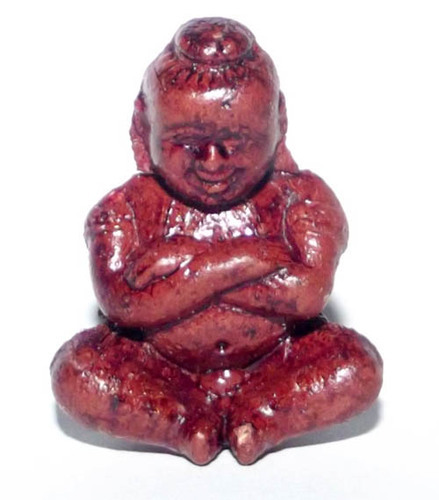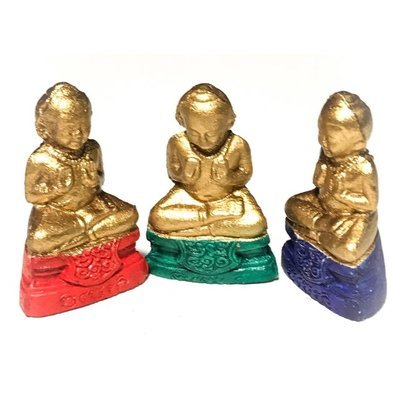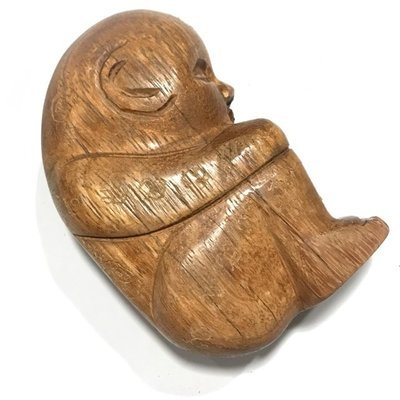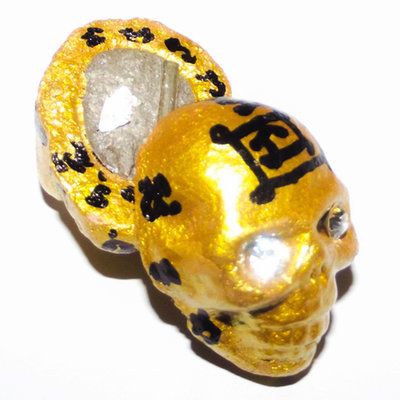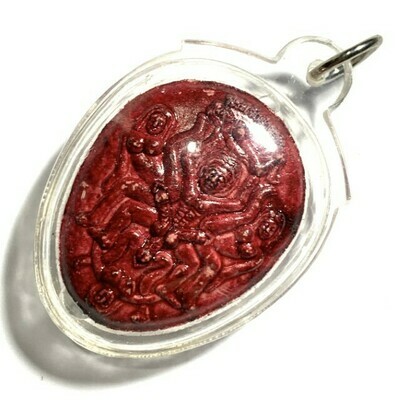

Thailand Amulets
Thai Buddhist and Magical amulets for Wealth, Health, Love and Happiness.
Vast Selection of Amulets
We have a vast selection of over 4000 different kinds of Sacred Amulets and Bucha Items, including Buddha Image, Loi Ongk statuettes, Buddhist Monk Coin Amulets, Takrut Charms, Nam Man Prai Oils, Mai Kroo Wands, Mitmor Ritual Knife, Lek Lai Kaya Siddhi Elemental Substance, Kumarn Tong, Gambling Amulets, Mae Nang Prai, Muan Sarn Sacred Powder Amulets, Palad Khik, Animist Charms, Necromantic Amulets, Buddhist, Animist, Brahman and Necromantic Amulets.
Kuman Tong Yord Paetch Amulet by Luang Por Ta Analayo of Wat Pha Kong Kam Chee Traimas 2555 BE Edition
The Kumarn Tong Yord Paetch amulet made by Luang Por Ta Analayo represents a golden boy holding a diamond in his hands. Approximately three years prior to the making of these amulets, Luang Por Ta had a dream about a young boy who came to him and asked to stay with him. In this dream, the young boy was sat naked with no clothes, and said his name was Yord Paetch. The young boy wanted to stay with Luang Por Ta to help make merits together. Hence, Luang Por Ta decided to make the Kumarn tong amulets according to the image of the spirit of the young boy which he had seen in his dream.

The Kumarn Tong Yord Paetch is made from muan sarn aathan sorcerous earths and powders, including 7 cemetery earths, 7 swamps earths, earths from 7 busy ports, 7 giant termite mounds, powdered forehead bone of a nang prai spirit, ashes of burnt bones from 7 funeral pyres, brokenhearted lady powder, special powders for reanimation of the spirit, and kumarKumarnn tong herbs. Next, the sacred earths and powders were mixed with see pheung salika long rang (metta balm of the sariga bird getting in the wrong nest') and nam man sanaeh nang krung (metta oil of the 'lady wrapped around the phallic'). All these sacred ingredients were then mixed together. From this mixture shapes of the Kumarn Tong Yord Paetch were pressed as amulets, and then empowered with incantations for a period of three years.

Most of the time, Luang Por Ta would perform the empowerments during the night time in the cemetery. He would then take a piece of red cloth ('pha daeng') and place it on the floor and put the Kumarn tong amulets on the cloth, all touching each other face to face, which is a part of rap sap magic for receiving treasures. Every Buddhist holy day Luang Por Ta went to the cemetery to perform empowerments from about 9 o' clock in the evening until midnight. Also, he performed the rituals to invite the devas of the highest celestial realms to come and join the consecration ritual of the Kumarn Tong Yord Paetch amulets, and thereby transmit deva minds into each amulet with their own individual spirit inhabiting. Luang Por Ta Analayo used the kata agarn sam sip song and hnun taat see for invocation of the thirty-two parts of the human body, and reanimation of the four elements. The amulets are blessed chanting the kata back- and forwards.

Hence, the Kumarn Tong Yord Paetch are empowered to keep enemies away and to protect against evil spirits. Also, the Kumarn tong are powerful amulets to attract maha lap great lucky and wealthy fortunes. Thus, the Kumarn Tong Yord Paetch are very useful for those who are in sales or market places, to increase the commerce and success in business. This is why the Kumarn tong is very popular with shopkeepers and other kinds of traders.

A remarkable fact about this amulet, which often has been noticed by many devotees, is that when one thinks of something one would like to have, then within a very short time one gets it without even asking for it. And so, the rate of coincidence with these events has caused this amulet to gain fame for its wishfulfilling power.

Kata Bucha Kumarn Tong Yord Paetch
First recite the Maha namaskara ('Namo Tassa...') three times, then chant:
Ehi kumarang kumariinang ati uni na ang piti putto.

Kata to call the Kumarn Tong (Kata Riak Gumarn Tong)
Aehi Kumaaro Aehi Kumaaree Aehi Rak Yom Aehi Prai Tong Bpiyang Ma Ma
Bpudt-Dtang Wasaayadti Aaragkhaana Bpajjayo
Rao Rak Yom Kumarn Tong Jong Maa Aehi Ma Ma
(Can be used for Rak Yom, Kumarn Tong, Prai Faed, Prai Tong)
Alternative Version;
Om Paniji Jaeruni Pantang Aehi Ma Ma
- When you go places or enter and leave buildings you should speak to the Kumarn in your heart to accompany you
- When you eat you should speak in your heart that the Kumarn should come to eat with you. Make a separate offering do not give from your own plate.
- The Kumarn will call friends. customers and riches to you, lovers and admirers, and will chase away enemies and protect you and your household and family.
- When bringing the Kumarn into the home for the first time, you should tell the Kumarn that the people in the house are friends and that the Kumarn should accept and look after them too.
Kata for empowerment of Kumarn Tong
Aehi Gumaarang Udti Uni Na Ang Idti Putto
Kata for calling the Kumarn to eat
Jadturapuudtaanang Ahang Waayang Ammahaara Kumaarang Kumarn Tong Maa Rap Pochanaa Aakajchaahi Dtiwadtabpo Aakajchaaya Maa Look Maa (Luang Por Jong, Wat Na Tang Nork, Ayuttaya).
Kata Pluk Kumarn Tong
Na Ma Pa Ta Gumaara Phuudti Bpadti Ruu Bpang Naama Dtae Laapo Namo Hoemi (Chant 3 Times to Awaken the Kumarn)
นะมะพะทะ กุมาระภูติ ปะติรูปัง นามะเตลาโภ นะโมโหมิ
Download as a WMASoundfile; Kata Pluk Kumarn Tong
Kata Perm Rit Kumarn Tong (Charge up Power)
Dtaadta Paya Bpudt-Dta Aehi Jidt-Dtang Bpiyang Ma Ma
Download as WMA Soundfile; Kata Perm Rit Kumarn Tong Plai Dam Khmer – Pra Ajarn Sak – Wat Ta Ee
Kata Atithaan Kumarn Tong (Ask for Wishes to be Granted)
(Maha Namasakara x 3 first)
Ja Pa Ga Sa Jid-Dta Mahaa Jidt-Dtang Bpiyang Ma Ma
Download as a WMA soundfile Kata Adtithaan Kumarn Plai Khmer Dam Pra Ajarn Sak Wat Ta Ee
Kata Gamgab Kumarn Tong (To Command the Kumarn on a Mission)
Gumaarang Bpadt Sandtang Plaay Yanaa Mahaa Su Wi Sae Tha Itti Rit Mutu Dtaanang Sud Suu Sang Mahaa Chanaa Dti
Download WMA Soundfile Kata Gamgab Kumarn
How to Worship the Kumarn Tong
Kata Adtithaan Khor Lap
(Use to make wishes and ask for Lucky Blessings, or to win the Hearts of Others).
Aehi Jidt-Dtang Jidt-Dta Pantang Pakinimae Jidt-Dtang Pantang Bpiyang Ma Ma
(hold the amulet between palms and in praying position between the eyebrows, chant three times and blow onto the amulet, making your wish).
Kata Kumarn Tong Prai Faed (Kumarn Tong Twins M/F)
Om Kumaaro Kumaarang Kumaarii Kumarn Tong Phlaeng Rit Hai Choke Hai Laap Kaa Khaay Gam Rai Dii Ma – A -U Om Kumarii Kumarn Tong Jong Phlaeng Rit Maa Chuay Dua Therd Aehi Jidt-Dtang Bpiyang Ma Ma Maa Ma Maa Maa Aehi Aehi Om Na Mo Put Taa Ya Ja Pa Ga Sa Ma – A – U Na Ma Pa Ta
How to care for the Kuman Tong Deity, and which Kata to Chant;
Before you enter the house with the Kuman for the first time, light 36 incense sticks outside and pray to Mae Toranee (Mother Earth), Jao Tee and Jao Tang (the various local Deities, Devas and spirits), and other sacred presences in the household and family environment. Let your mind send a communication to the Kuman and let him know that you are inviting him to come and stay with you. Now you should also give a name to the Kuman Tong, one which you can easily remember at best.
Kata for giving the Name to the Kuman (chant when giving him his name).
“Naamaanang Samaa So Yudt Dta Tho Yudt Dta Tha” “In the Name of the Kroo Ba Ajarn – I name you (Name which you wish to give your Kuman Tong”.
Say this 3 times, and the next day chant only once. You must always remember his name and must introduce him to all people in the house, and ask him to also protect and lend prosperity to them all.
Kata Riak Kuman (Kata to call the Kuman Tong)
Chant to the Triple Gem first; ‘
Na Mo Dtassa Pakawadto Arahadto Sammaa Samputtassa
(3 times), then Chant the following Kata One time;
Gumaaro Waa Gumaaree Waa Aehi Jidt-Dtang Bpiyang Ma Ma Na Chaa Lee Dti Na Ma Pa Ta Aakajchaeuya Aakajchaahi Maani Maa Maa
Kumarn, or Kumara (Pali) means “young boy” (young girl would be “Kumaree”), Tong means golden.
Kumarn Tong (alternatively spelled “Kuman Tong”), is not a Buddhist practice, rather pure “Saiyasart” (Occultism, in this case, Necromancy). It would also be accurate to class the practice of keeping Kuman Tong as an essentially Animist practice. The genuine Kumatn Tong which was revered and created in Ancient times according to traditional method, by Adept practitioners of Saiyasart, was made by surgically removing the unborn fetus of a child from the womb of its Mother. The body of the child would then be taken to a cemetery for the conduction of the Ceremony to invoke a Kumatn Tong. The body is roasted until dry whilst the Mage chants incantations of Magical Kata. In the case of making a female spirit child, the effigy is not called Kumarn Tong, rather “Hoeng Pray”.
Some Kuman effigies will be soaked in Nam Man Prai, which has extract of a dead child or a person who died in violent circumstances or an unnatural death. This is much less common now, due to the fact that this practice is now illegal if using fat from human babies for the consecrating oil. There are however still some authentically made amulets appearing. Some years ago a famous monk was thrown out of the Buddhist Sangha for roasting a baby. He was convicted, but later continued to make magic as a layperson after his release. The practice of creating Necromantic effigies of a Kumarn Tong comes from age old tradition in Siam. Thai folk have made Bucha to Animistic spirits and ghosts since time immemorial. The original Kumarn Tong came from children who died whilst still in their mothers womb. The Magic makers would take these stillborn babies and adopt them as their children. From what information has been gathered from ancient Thai manuscripts about how to make a Kumarn Tong, it appears that the correct method is to remove the dead baby surgically from the mothers womb, and take it to undergo the proper ceremonial ritual; The baby must be roasted until dry. This must be completed before dawn, and should be performed in a cemetery. Once the rite is completed, the dry roasted Kumarn should be painted with Ya Lak (a kind of lacquer used to cover amulets and Takrut with gold leaf), and covered in gold leaf. This is the real reason why this effigy received the name of “Kumarn Tong” (which means “Golden Baby Boy”).
Kuman Tong in Modern times
As society developed and became “Civilized”, the practice of roasting dead babies became legally impossible to do, and so an adaptation of the making method was developed. One of the ways was to make a clay effigy using the earth from seven cemeteries, Mai Rak Soorn wood, or Mai Mayom wood was also used for making Kumarn Tong statues. Even iron is now used for the making of Kumarn Tong effigies. To invoke the magical power, the effigy is implanted with Kata to bring the Kumarn to life.
This is done by using Kata Taat See (invoking four elements), and Kata Agarn Sam Sip Sorng (32 parts of the Human body). It is believed, that this will cause the mind and spirit of a dead boy to arise within the effigy. Modern Kumarn effigies normally have curly hair, whereas the older style ones are bald, a should be the case with an unborn baby. The traditional methods state that a Kumarn must be treated like your own child. He must be offered food and drink, and even be called to come and eat every single time you are about to have the meal. It is believed that if the Kumarn is handled properly according to the correct ceremonies, he will then protect the house and its inhabitants from danger, and increase good business too.
How to revere Kuman Tong
In Modern times, is has become common practice to offer “Nam Daeng” (a kind of red syrup drink), incense and flowers. This is of course done in moments of prayer or ceremony, but it should never be forgotten to call to come and eat when it is the meal time.
Modern Kumarn Tong statues are mixed to a special formula, which varies slightly depending on the creator. One of the currently popular Kuman Tong makers of the moment in Thailand is Hlwong Phu Yaem of Wat Sam Ngam in Nakorn Pathom. He makes his statues according to the Dtamrap (recipe) of the Masters of the lineage who taught him the Wicha of Kuman Tong. His statues contain the following ingredients in the clay mixture;
- Earth from 7 cemeteries
- Ashes of burnt bones taken from 7 Meru Chedis (relic Stupas)
- Earth from 7 salt licks
- Earth from 7 sacred caves
- Earth from 7 river mouths
- Earth from seven fields or gardens
- Ashes from the burnt bones of 7 dead children
- broken pieces of temple wall
The clay is then baked according to the traditional method, and the resulting statue is then given “Pluk Sek” (incantations) and empowered during a period of one year.
Kata Suad Bucha Kuman Tong (Dtugadtaa Tong)
Putassa Buchaa Tamassa Buchaa Sangkassa Buchaa
Badti Badti Buchaa Pawandtumae Ugaasa Ugaasa
“I beg to revere the Dtugadtaa Tong, that consciousness arises in the eyes, the mind, the body of the Kuman. Through all the merits I may have accumulated since endless lives uncountable, may all great fortunes and blessings come to me from all eight directions. May these blessings be bestowed on me through the Dtugadtaa Tong, who I shall pay offerings and respects to, and maintain with nourishment and caring affection each and every day. The word “Dtugadtaa means “Doll”.
Before you decide whether you want to have a Kuman Tong, you should seriously consider whether you have the time and pacience to keep the strict rule of not neglecting the Kuman Tong, offering food and drink every mealtime. The Kuman Tong practice is pure Saiyasart and a form of Necromancy. This kind of practice is a matter of your personal choice whether you see fit to “Liang Kuman Tong” (rear a golden child). For Buddhists of the purist traditions, the Kuman Tong is not part of the practice of Buddhism, but if you are not a Buddhist and view the matter from the point of view of an occultist, or a person looking for magical assistance, then perhaps the Kuman Tong is the thing for you.
How to Worship Kuman Tong (Traditional Method);
The first time you bring a Kuman to the home, you must first light 11 incense sticks, and ask the local Devas for permission to bring the Kuman into the Dwelling area.
Then use 5 incense stick to bring the Kuman into the house.
Light the 5 incense stick on the Buddha Bucha altar. Place the Kuman on a separate al;tar, or at least lower than the Buddhas or Monk images.
Kuman Tong Full Ceremonial Method
Chant and make offerings every morning and evening, and chant the Nippana Sutra for Prai 7 times each session (always chant Kata to the Triple Gem 3 times before any other Kata Chanting).
Kata for calling the Kuman Spirit to come and be your companion
Jijeruni Jidt-Dtang Jae Dta Sigang Ruubpang Nippaanang Dtang Nippudting Pa Ta Na Ma Dtaecho Taadtu Tikang
Waa A Sa Ja Pa Waa Dto Saen Dto Aegachaanang Barang Yadtawaa Aakajchaahi
Kata for invoking the Kuman to come to life and do jobs for you
Jijeruni Jidt-Dtang Jae Dta Sigang Ruubpang Nippaanang Dtang Nippudting Ma Pa Ta Na Bpathawii Taadtu Tikang Waa Pa Ga Sa Ja Waa Dto Saen Dto Bpas Saa Hattayang Siwang Chiwang Udt-Dtaedti
Kata for fending off or chasing away Kuman or Prai spirits
Jijeruni Jidt-Dtang Jae Dta Sigang Ruubpang Nippaanang Dtang Nippudting Na Ma Pa Ta Aabpo Taadtu Tikang Waa Ja Pa Ga Sa Waa Dto Saen Dto As Saa So Nippaanang Suunyang Kajchadti
Kata for telling the Prai (Kuman Tong) to stay put in a place
Jijeruni Jidt-Dtang Jae Dta Sigang Ruubpang Nippaanang Dtang Nippudting Ta Na Ma Pa Waa Yo Taadtu Tikang Waa Sa Ja Pa Ga Waa Dto Saen Dto Puttaa Pantanaa Yagang Pan Tadt Dtawaa
Short Method
If you have little time and need a short way to do this, make offerings as usual with incense, rice whisky or fruits, savories and sweets, and use the following Kata for various purposes;
Heart Mantras of Nippanasut
- Sa A Ni So (call to come to you)
- So Sa A Ni (awaken and empower to send on missions)
- Ni So Sa A (use to ward away spirits and ghosts)
- A Ni So Sa (use to make the Kuman stay in one place)
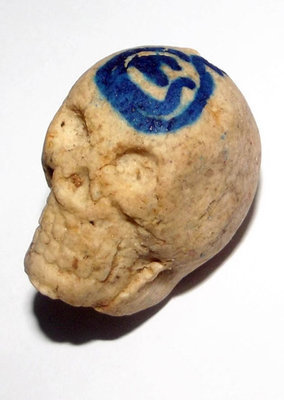
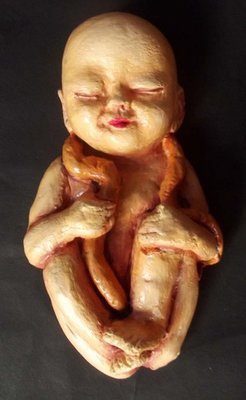
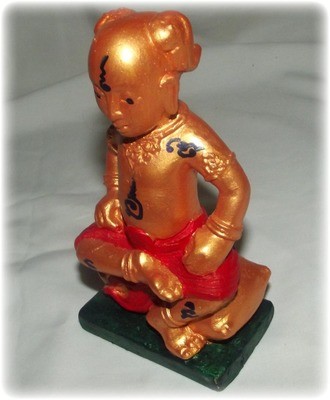
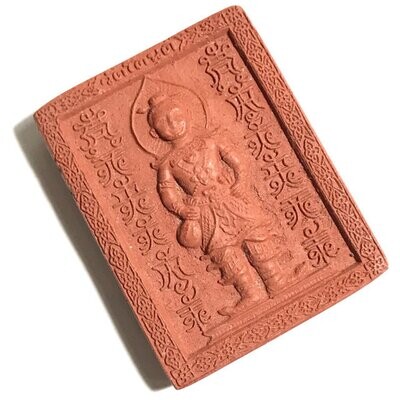
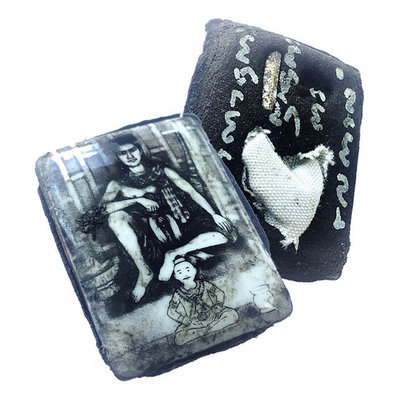
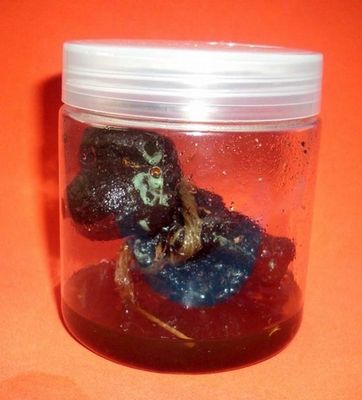
Contact Us
Follow Us on Youtube
About Us
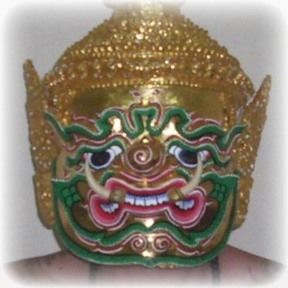
Ajarn Spencer
Proprietor
Thailand Amulets is owned and Administrated by Thai Occult and Amulet expert, Ajarn Spencer Littlewood who guarantees only authentic blessed amulets, and a free gift with every order, as well as his safe delivery or money back guarantee. https://facebook.com/ajarnspencer
